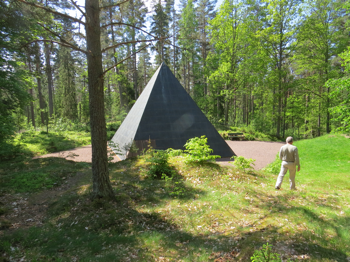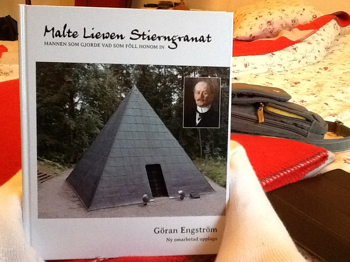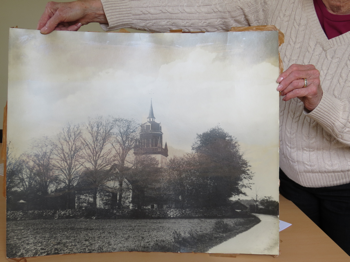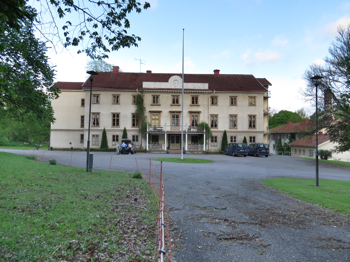We spent most of today learning about Augusta Mathilda Gustafsdotter. She was Dad’s grandmother on his father’s side. She was born in 1856 just a little ways down the road from where I’m sitting right now. Her mother, Clara Fredrika Jönsdotter and her father, Gustaf Adolf Carlsson, were both employed here at the Nobynäs Säteri (manor house) before Augusta was born.
At breakfast this morning, our host Ulla told us about the history of this house. She said it was owned by several generations of the Stierngranat family and when Clara was here, she would have worked for the last of the Stierngranats to live here. They had a son, Malte, who achieved quite a bit of notoriety both here and in America.
Over a period of time, Malte collected the rent money from the tenant farmers, kept it for himself, and then set off for America. There he had a series of adventures and misadventures, including a false promise of marriage for which he was jailed. He presented himself as Swedish nobility, befriended Theodore Roosevelt, and finally met and married a wealthy American heiress. He brought her back to Sweden where she was anxious to finally see the family estate. Unfortunately, since Malte had made off with the rent money, his parents had been forced to sell and had moved to town. Poor Marie, Malte’s wife, never did get over her disappointment.
Malte became more and more eccentric. For example, he always travelled with an oak casket, “just in case”. Not too long before he died, he commissioned the building of a small pyramid near the old estate, to serve as the burial tomb for he and his family. The pyramid is today a local tourist attraction, so of course we had to go and see it this morning:
 Later on, Nobynäs was converted to a nursing home and several of the building’s modifications date back to that era. It eventually fell into horrible disrepair and even sat empty for a few years. The neighbors wanted to buy it and raze it for more pasture land. The current owners bought it in the mid-90’s, saving it from destruction. They raise Frisian horses (kind of like Lippizaners) and some exotic sheep breeds. They host big dressage clinics here from time to time, and there is a huge indoor dressage barn on the property. The Bed & Breakfast brings in some additional income, as does the contract to provide temporary housing for the Croation power line workers.
Later on, Nobynäs was converted to a nursing home and several of the building’s modifications date back to that era. It eventually fell into horrible disrepair and even sat empty for a few years. The neighbors wanted to buy it and raze it for more pasture land. The current owners bought it in the mid-90’s, saving it from destruction. They raise Frisian horses (kind of like Lippizaners) and some exotic sheep breeds. They host big dressage clinics here from time to time, and there is a huge indoor dressage barn on the property. The Bed & Breakfast brings in some additional income, as does the contract to provide temporary housing for the Croation power line workers.
By the way, I splurged at the local visitor’s center and I now own a copy of Malte’s biography:
 Okay, so enough about the weird guy.
Okay, so enough about the weird guy.
After lunch, we concocted a driving itinerary to hit all the farms and churches where Augusta lived before she came to America. When she was 15, the family established itself on the Skallycke farm which today is listed for sale! It’s cute as can be with a barn and out-buildings, right on the bank of a small brook. I don’t believe the yellow house is from Augusta’s time but certainly some of the other buildings are.
 While we were visiting at the Lommaryd church (where Augusta was baptized), the groundskeeper offered to let us in. We got the full tour! The church as it stands now was actually constructed after Augusta left. He showed us a photo of the old building. Here is the beautiful Lommaryd kyrka, then and now:
While we were visiting at the Lommaryd church (where Augusta was baptized), the groundskeeper offered to let us in. We got the full tour! The church as it stands now was actually constructed after Augusta left. He showed us a photo of the old building. Here is the beautiful Lommaryd kyrka, then and now:

 After the farm/church tour, we set out for Gränna, a cute little tourist town on the shores of Lake Vättern. On to Jönköping for dinner, and then back to Nobynäs where the hot water has been restored!
After the farm/church tour, we set out for Gränna, a cute little tourist town on the shores of Lake Vättern. On to Jönköping for dinner, and then back to Nobynäs where the hot water has been restored!
Here’s Nobynäs in the evening light.
 Tomorrow we explore the Rudeen heritage at Marbäck kyrka and at Eket farm.
Tomorrow we explore the Rudeen heritage at Marbäck kyrka and at Eket farm.
